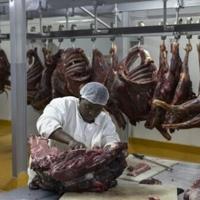Carcasses of impala, kudu, and wildebeest hang from a slaughterhouse rail, ready to be turned into steaks, sausages, and burger patties that South Africa aims to increase consumption of. The slaughterhouse in Bela Bela, located north of Johannesburg, is one of the few in the country that focuses on game meat. Authorities believe that developing this sector could lead to job creation, wildlife preservation, and satisfy the tastes of environmentally and health-conscious meat eaters.
South Africa produces around 60,000 tonnes of game meat annually but only a small portion is sold in markets. The majority is informally hunted and consumed. The country also exports only a fraction of its game meat. To address this, authorities have set a goal to grow the sector substantially by 2036, with a projected increase in revenue from 4.6 billion rand to 27.6 billion rand.
– Less methane –
Game animals release less methane than cattle, making them a more environmentally friendly option. In addition, they provide a lean and free-range meat source. Expanding game meat production could also positively impact conservation efforts. South Africa’s wildlife population has significantly increased in recent decades, and the government believes that converting communal land to game meat production could help boost black ownership in a sector currently dominated by white males.
– Meaty problems –
Despite the benefits of game meat, there are challenges hindering its widespread consumption and export. The belief that game meat is less tender and has a unique taste has led to low consumption. Quality standards, traceability, and testing facilities are also essential for boosting consumer trust and allowing exports to international markets. Addressing these issues is key to the successful growth of the game meat industry in South Africa.





